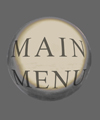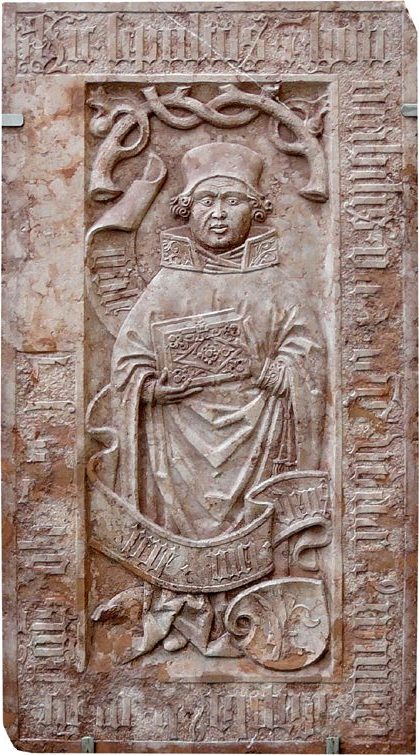For those who would enter into the world of Renaissance thought, the „Toll Collector’s House“ at Schüreplatz in Stein provides an ideal starting point. A forgotten gem of Northern Renaissance architecture, the Toll Collector’s House is one of a number of buildings and works of art in Krems and Stein that silently testifies to the presence during the Renaissance of a strong protestant inclination combined with an interest in humanism. This has been confirmed by an analysis of the books of wills and testaments drawn up the period. During the sixteenth century, there were thirty-three citizens who owned collections of books that numbered between three and 290 works. Whilst exts relating to the Reformation predominated, the works of Greek and Roman authors were also well represented. Among contemporary writers, Erasmus, Petrarch and Ficino were particularly popular. There were also specialised collections of medical texts and books relating to teaching and instruction.
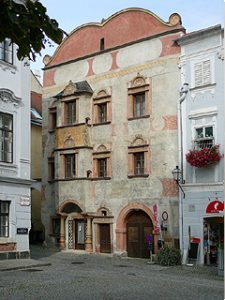
At ground floor level, one of the most noticeable features of the Toll Collector’s House are the columns that support the bay-window. These derive from a tradition that, lacking an in-depth understanding of the Greek orders of architecture, did not distinguish between genuine Roman capitals and their Romanesque descendants. This however led to an innovative and unrestrained approach that resulted in a uniquely northern European style of Renaissance architecture with a comparable example being the building known as „The Folly“ in Settle in the North of England. Adorning the Toll Collector’s House, enclosed in the ends of the scrolls that hide the gable end, there are relief portraits of Emperor Ferdinand I and his wife, Anna, whilst above the windows of the two-storey bay-window, there are the arms of Ferdinand and the imperial crown and eagle of Austria.
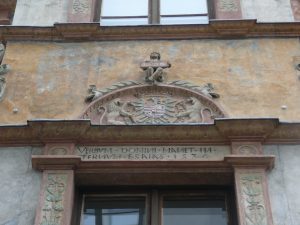
Above the imperial arms a cherub holds a tablet with an inscription that gives the date when the house was completed in 1536. Below, there is the inscription: Jupiter in coelis Caesar regit omnia terris 1536. This translates as: „Jupiter, the heavenly Caesar rules all Earth“. Meanwhile above the first floor window, a second inscription reads: Verbum Domini manet in aeternum ex. This is taken from Isiah 40:8, in which the prophet says: „The grass withers and the flowers fade but the word of the Lord endures for ever“ with the inscription only giving the second phrase. The emphasis on the Word of God that suggests a Protestant inclination, while the inscription above implies a humanist learning, with both being confirmed by other reliefs and their encircling inscriptions. Meanwhile the building’s other decorative elements consist of dolphins and floral motifs.
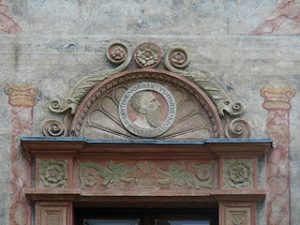
These are typical for the Renaissance and the whole can be seen as deriving from a style of decorative, ornamental painting known as grotesque. Here motifs such as flowers, birds, masks and dolphins are joined together by curving decorative lines. With respect to painting and ornamentation, the word „grotesque“ means „grotto-esque“ and refers to discoveries made in 1479, when in Rome, the painted rooms of Nero’s Domus aurea were discovered. As these lay buried under the deposits of the intervening centuiries, they were described as „grottos“. Far from being put off by the disparaging remarks made in On Architecture by the Roman writer and architect Vitruvius, who objected that such imagery was un-natural, humanists of the Renaissance relished the playfulness and endless recipies of invention. Re-interpreting the murals, Renaissance artists evolved a form of ornamentation that going beyond the strictly ornamental, was alive with interconnected elements, flowers for example, being linked with masks, whilst singing birds stand next to dolphins, all held together by filigrees of twirling, interconnected lines. From around 1485/1490 onwards, this style of decoration became highly fashionable and although over the decades, it became mannerised and lost its spark, a lively example can be seen in Museum Krems. Consisting of a panel, the fresco shows interconnecting leaves and flowers, an urn and ornamental, metallic objects.

A little further on at Steiner Landstrasse 92, between the Late Gothic architectural features, patchy fragments of this style of painting may also be seen. In this way, artists of the Renaissance and their hummanist patrons re-awoke a long slumbering vision of a world as a labyrinth of interconnection in which things, by virtue of being interconnected, had a latent capacity for metamorphosis. That this was really how people of the Renaissance saw the world, is demonstrated by Augustino Ramelli’s Various and Ingenious Machines of 1588. This shows the interactions of wheels, gears, cog-wheels and cams with such things as buckets and fans in a way that includes püsterrich’s, gargoyles and caryatids with all being connected through the transformations of various kinds of force.
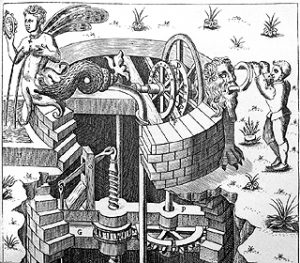
In its pure and non-mannerist manifestations, grotesque painting and other such forms of ornamentation reflect this and a fresco in Museum Krems and the museum’s „Kappler Cupboard“ are both authentic expressions. Like the Toll Collector’s House in Stein, with which it is comparable, the Kappler Cupboard is an important work of applied art and was imported from the South of Germany into Austria by Wolfgang Kappler.
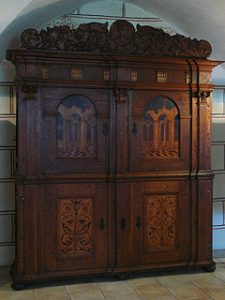
Born in Strasbourg, Doctor Wolfgang Kappler evidently came from a wealthy family as he had been able to study medicine in Venice. Thereafter he practised as a physician in Brno, before moving to Znaim, where he practised as an apothecary. In 1527, he received an invitation to be made a burgess of Krems, should he chose to move there. Accepting, Kappler bought a house at the intersection where Obere and Untere Landstrassen meet the Tägliche Markt and the Marktgasse and moved with his family to Krems.
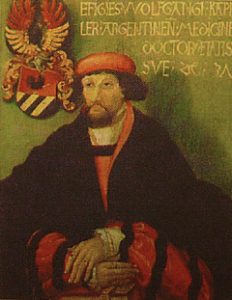
A portrait in Museum Krems shows him wearing a red beret, which, like the book on which he rests his hands, shows that the person depicted is someone of education. To the left of him there are the Kappler coat of arms. While a black cockerl enclosed by a pair of wings serve as a crest, in the upper half of the shield below, a black cockerel is set against a red background. In the lower half there are green and gold, diagonally slanting stripes. Kappler’s arms were bestowed upon him by Emperor Charles V and are among the 29 coats of arms that adorn the burghers‘ club room in the Gattermann House. Of his wife, Magdalena Gmundner, little is known except that she was the daughter of a baker and the mother of the couple’s thirteen children.
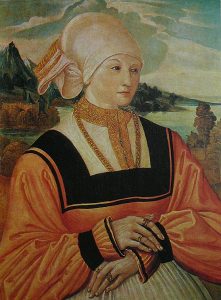
A portrait of her that is likewise on display in Museum Krems and which is possibly by Wolf Huber, shows her in her best clothes, bemused at what was evidently an unaccustomed moment of peace. On the other side of the panel a different artist has shown Wolfgang Kappler asleep with the family tree of his dynasty growing out of him. Hanging from the lower branches of the tree there are the coats of arms of Kappler and his wife, with Magdalena’s arms being a white shield cut by a black diagional on which there are the red blades of three spades.
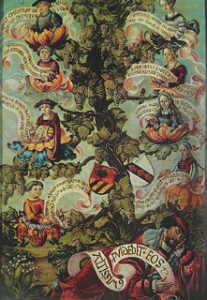
Doctor Kappler is known to have supplied the alchemists who worked in a laboratory at Oberstockstall near Kirchberg am Wagram. Here in 1980, hidden in a Medieval grain storage pit, an entire inventory of laboratory equipment was found, with all the vessels, retorts and crucibles that one would associate with the „secret art“. Unfortunately nothing is known about program pursed by the alchemists at Oberstockstall except that towards the end of the laboratory’s expected period of use, a fraudster, who was later arreseted in Nuremberg, worked there nine months. Meanwhile at the Kappler House in Krems, there is still to this day, an apothacary on the groundfloor, while in Museum Krems apothacary’s jars from the period may be seen.
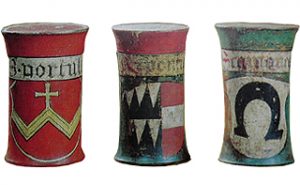
The Kappler House is distinguished by a depiction of summer that is mounted on the corner of the building. Like the portraits of Kappler and his wife, the original is on display in Museum Krems and shows a figure so darkly tanned by the summer sun that the apothacary became known as the Moor’s Apothacary. Below the figure there are the shields of the arms of Kappler and his wife. Not himself an alchemist, the house of Doctor Kappler nevertheless testifies to a process of transformation and immediately around the corner from the personification of summer, there is a relief that depicts a wild man who in one hand holds a pruning knife, whilst in the other he supports the Kappler coat of arms, below which, as in the portrait, there is a book.
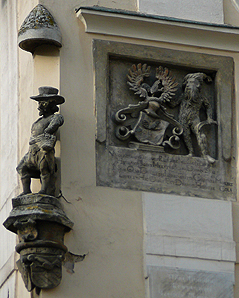
In 1532, the house was destroyed by fire and on the Obere Landstrasse side, below the statue of Summer, an inscription reads:
In this year of 1532 when Emperor Charles waged war against the Turks, this house was burnt down but within two years, Wolfgang Kappler, medicus, built the same.
The motif of the wild man occurs repeatedly in Medieval and Early Modern Age art and is a feature of both Slavic and Germanic folklore. The wild man would appear to derive the Roman god, Silvanus. Thought of as a friendly god of woods, who would plant trees in desolate places and tend to neglected saplings, Silvanus was also a god of herded animals. Wild men like Silvanus were imagined as bearded, rustic types who, apart from a wreath worn around their heads made of woven pine branches, wore nothing but their birthday suits and walked about naked. Silvanus is mentioned in Virgil’s Georgics and as established by Paulhart, during the Renaissance Virgil was known and read in Krems. The wild man who supports the Kappler arms wears what is generally seen as a turban but might equally be a woven crown of foliage that spirals up into a point. Sixteenth century depictions show wild men wearing a second wreath which was woven around their hips to ensure decorum and hide that which should be kept hidden. A sixteenth century, life-size figure of a wild man cast in bronze in Salzburg, shows the wild man as being covered in fur and this is also the case with the figure above the Kappler apothecary.
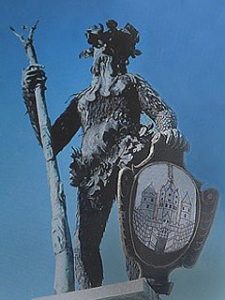
This raises the possibility that a body of writing known as the Corpus Hermeticum might have been a third source of inspiration for the choice of a wild man as a supporter for Doctor Kappler’s coat of arms. During the Renaissance the Corpus Hermeticum was thought to have been written by a „thrice-great Hermes“ and in the inscription below, there is also a reference to one whose greatness is also three-fold. This is Emperor Charles V, who was king of Spain, Austria-Hungary and the Spanish Netherlands and the inscription records that the insignia were given to Kappler by the three-fold king/emperor. A central tenet of the Corpus Hermeticum and of the Renaissance in general, was that correspondances and parallels were to be found everywhere. If there was a thrice-great king on Earth, this implied that there was someone in the heavenly realm who was also thrice-great ̶̶ the Hermes Trismegistos of the Corpus Hermeticum. Echoing this, the inscription below the wild man points out that the awarding of a coat of arms was a sign of merit and while he who bears them is corporal and mortal, he nevertheless has the capacity to address and pay homage to all that is divine. Responding to the resonances of the heavens, the microcosmic world of the soul was seen as being atttuned to the movements of the macrocosm. At the heart of each individual there thus lay a spark of divinity which had the capacity to radiate out from the person in which it was kindled. Through ignorance and bad habits however, the divine spark was often stifled and suffocated. By the time it reached the skin of a neglected and ill-kept body, what was once divine was nothing more than an animal-like, hairy, hide of sensory impressions. Where the purest form of matter was seen as being air, the purest form of air was soul, while the purest form of soul was spirit and the purest form of spirit was God. In this way, correspondances had the capacity to lead up to God.
The correspondences betwen microcosm and macrocosm and the capacity for the soul to become purified and abandoning its hairy hide, ascend up towards the true light may also be the thinking lying behind the wild men shown on pocket sundials of the period. Where the movement of the sun through the sky marks out the passing of time on a macrocosmic scale, the shadow cast by a gnomon of a sundial marks it out on the level of the microcosm with the latter movements being watched excitedly by the onlooking wild men.
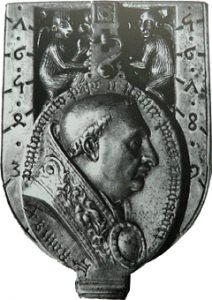
A sundial made by the mathematician and astronomer, Regiomontanus, for Pope Pius II. For more on Regiomontanus ses „Laborum mathematicum“ accessible through the menu on the Mission Page.
Reminiscent of Silvanus‘ sickle, the pruning knife held by the wild man on Doctor Kappler’s house invites the interpretation that, through a judicious treatment of physical aliments and a disciplined and appropriately thought out catering of bodily needs, the animal hide of the flesh can be purified and the divine spark within allowed to shine through. Kappler’s arms form the subject of a relief that is on display in Museum Krems, below which there are the arms of Magdalena on the one side whilst on the other, there is a shield with a loaf of bread and a pretzel.
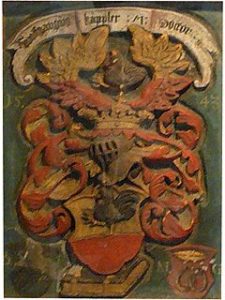
Although the bread and prezel refer to Magdalena Kappler, it may well have been intended to awaken other connotations as well. In alchemy, while the beginning of the great work is symbolised by green which is the background colour against which the shield and crest are placed, the end of the work is symbolised by red, whilst golds stands for the uncorruptable perfection of what is attained. Meanwhile the occurance of bread recalls the Last Supper whilst the cockerel hints at the betrayal that is to follow. Yet the cockerel can also be seen as standing for the concept of the right time and the judicious moment. In the normal course of events, Doctor Kappler would have made a will that would have been recorded in the town’s Book of Wills and Testimonies and here the books he owned would have been listed along with the names of whoever was to inherit them. As recorded by the Book of Wills and Testimonies however, Kappler made other arrangements and made three testaments privately. Thus it cannot be proved that he owned either a copy of the Corpus Hermeticum or of Virgil’s Georgics. Nevertheless it is known that he owned books, including a valuable medical codex and it is likely that the number of books he owned was not insignificant.
An important feature of Renaissance architecture was the opening up of courtyards, with prominent arcades and loggia’s on the first and second floors. In both Krems and Stein examples abound such in the Dachsberggasse in Krems.
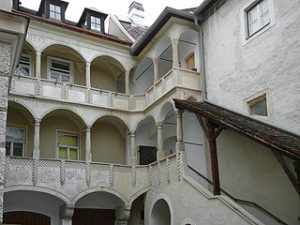
Like bay-windows, these enabled residents to see and be seen, yet arcades also allowed rooms to be accessed individually, so that with the new architecture, there came an increase in privacy. Meanwhile oven-builders had perfected the art of making stoves that, sending smoke and toxic emissions up the chimney, generated a warm and cosy heat in which reading and discussion could flourish. In a woodcut from the period, a merchant and his family are shown in a „Stube“ or sitting room which is heated by the stove depicted on the right-hand side.
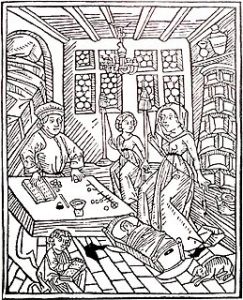
The various members are engaged in different activities and while the merchant attends to his accounts, his wife and daughter are engaged in spinning. While the youngest member of the family lies in a cradle on the floor, in front of the merchant, a boy is shown reading a book. As shown in the wood-cut, on the outside, the outer lining of such stoves was formed from tiles which after being clamped together, were bonded and sealed with clay. In Museum Krems a number of ornate oven tiles are on display in the cellar, with the most ornate example dating from the Renaissance.
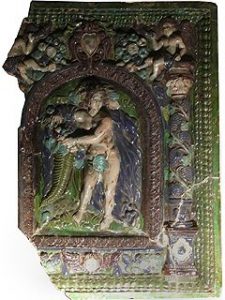
Renaissance architecture thus brought atmospheres into being in which reading, discussion and private study were engendered and fostered.
Reading lies at the heart of humanism and the Renaissance is seen as being inaugurated by the writings of Petrach, Dante and Boccaccio. In the writings of these humanists, man was placed centre-stage and the world was no longer seen as a place of trial and temptation but instead as a place that had a value in its own right. In his Decamerone, a series of witty sketches, Boccaccio gave an unprecedentedly realistic depiction of life and people in the fourteenth century. Humour confronts the reader with the fact that different people have different ways of seeing the world and that when different perspectives and different habits collide, the results can be funny. For humour to work however, the different points of view portrayed have to be believably entered into by the writer and the concerns of the protagonists presented in a manner that convinces and is absorbing. Inspired by the writings of ancient authors, writers of the Renaissance avidly studied classical texts, noting how openly discussions were held on such matters as whether the gods existed and if they did exist, were they really as interested in human affairs as was generally supposed? Writing further has the capacity to allow a reader to enter into the worlds of complex characters who may be anything other than open, accessible or sympathetic. In reading a writer’s reconstruction of a character’s thoughts, fears and concerns, we are miraculously endowed with the facility to enter into the mind of a person vastly different from ourselves and are able to understand why they think and feel as they do. The reading and writing of quality literature thus lies at the heart of humanism. Coupled with this is the ability to examine and compare texts, bringing our critical faculties to bear on what they have to offer. Where people of the Middle Ages saw the world as series of traps, pitfalls and temptations, during the Renaissance, the world was seen as a labyrith of signs that it was man’s task to decode and explore. In his The Assayer of 1623, Galilieo wrote:
Philosophy is written in this grand book, the universe, which stands continually open to our gaze. But the book cannot be understood unless one first learns to comprehend the language and read the characters of triangles, circles and other geometric figures without which it is humanly impossible to understand a single word of it; without these, one wanders about in the dark labyrinth.
A book wheel designed by Ramelli echoes this view of the world and is often seen as a precusor of the internet and in any case represents an in-between stage between a table laden with books that are open at different pages and the internet as we known it. Recalling the winged soul who hovers over the Medici coat of arms in Cosimo’s copy of the Corpus Hermeticum, as observed by Gustav Renée Hocke in his The World as Labyrinth, at the centre of Ramelli’s book wheeel there is a genius who personifies the spirit of reading and who endlessly peruses the labyrinthine texts of the world.
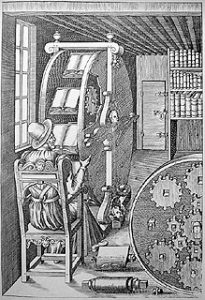
A sixteenth century library and reading machine from The Various and Ingenious Machines of Augostino Ramelli, 1588
In modern terms, the vision of the world as a labyrith of interconnection finds its counterpart in a theory of truth developed by Alexander Curtis. Here, although there are things that can be said about the world that are true, looking at something one way, whilst engendering the possibility of there being one kind of truth or sets of truths, at the same time closes off other sets of truth from view. This does not mean that these other truths do not exist, nor does it entail a fundamental relativity, it simply means that the two sets cannot be seen, contemplated or understood at the same time from a single point of view. The process by which one set of truths screens off other sets from view can be graphically represented and results in a labyrinth in which some things are seen and others are not. See „On Truth“.
